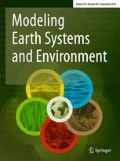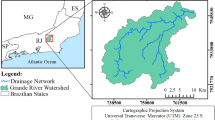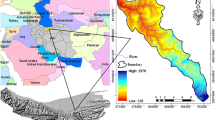Abstract
Sustainable land use of watershed is an important aspect for the development and conservation of nature. Unconcerned use of the resources may lead to irreversible consequences and overall misbalance. The main aim of the research was to create a software, which could be useful for estimation of the catchment’s nature conditions and assessment of changes on the basis of which the prediction of possible consequences can be made. In the given work, the influencing factors have been considered: precipitation and temperature analysis and land cover change over the last 30 years. With the help of the developed model based on the provided data, the representation of changes in climate, land cover and water dynamics were calculated. As a result, the software establishes the characteristics of the catchment area and makes it possible to see the changing pattern of the selected factors. The primary and secondary outcomes of the model provide precise calculation of surface runoffs, interception losses, and transpirations. In order to assess the effectiveness of the model, the results of the model and the river discharge were compared with estimation of the possible error rate. Different territories with similar characteristics can implement developed software for daily use on the local level. However, for successful applying in a new area the model has to be localized. Further evolvement is necessary in order to make the model applicable to any different location with specific features which can be different from the original example provided.











Similar content being viewed by others
References
Alexander L, Zhang X et al (2006) Global observed changes in daily climate extremes of temperature and precipitation. J Geophys Res 111(D5):22
Bonan, G. B., S. Levis, et al. (2003). A dynamic global vegetation model for use with climate models: concepts and description of simulated vegetation dynamics. Glob Chang Biol 9(11): 1543–1566.
Bruijnzeel, L. A. (2004). Hydrological functions of tropical forests: not seeing the soil for the trees? Agric, Ecosyst Environ 104(1): 185–228.
Calder, I. (1992). The hydrological impact of land-use change. Proceedings of the conference on priorities for water resources allocation and management, natural resources and engineer advisers conference, Southampton.
Carpenter, C. and R. Zomer (1996). Forest ecology of the Makalu-Barun National Park and Conservation Area, Nepal. Mt Res Dev 16:135–148. Doi:10.2307/3674007
Croke J, Mockler S et al (2005) Sediment concentration changes in runoff pathways from a forest road network and the resultant spatial pattern of catchment connectivity. Geomorphology 68(3):257–268
Eiumnoh, A. and R. P. Shrestha (2000). Application of DEM data to Landsat image classification: evaluation in a tropical wet-dry landscape of Thailand. Photogramm Eng Remote Sens 66(3): 297–304.
Foody GM (2002) Status of land cover classification accuracy assessment. Remote Sens Environ 80:185–201
Fritzsche, P. (2010). Development of a satellite-based dynamic regional vegetation model for the Drâa catchment, Citeseer.
Gerten D, Schaphoff S et al (2004) Terrestrial vegetation and water balance—hydrological evaluation of a dynamic global vegetation model. J Hydrol 286(1):249–270
Houghton R, Lambin E et al (2006) Global land-cover change: recent progress, remaining challenges. Springer, Berlin
Kaly, U. L. (2004). Review of Land-based sources of pollution to the coastal and marine environments in the BOBLME Region. Unpublished report prepared for the BOBLME Programme. Unedited version at http://www.BOBLMME.org.
Lal R (2003) Soil erosion and the global carbon budget. Environ Int 29(4):437–450
Matteo M, Randhir T et al (2006) Watershed-scale impacts of forest buffers on water quality and runoff in urbanizing environment. J Water Resour Plan Manag 132(3):144–152
Mouazen, A., M. Maleki, et al. (2007). On-line measurement of some selected soil properties using a VIS–NIR sensor. Soil Tillage Res 93(1): 13–27.
Nepal W (2013). Chitwan annapurna landscape (CHAL): a rapid assessment. World Wildlife Fund Nepal
Osti R (2005) Indigenous practices for harvesting water from streams in the semi-arid environment of Nepal. Int J Sustain Dev World Ecol 12(1):13–20
Palmer MA, Reidy Liermann CA et al (2008) Climate change and the world’s river basins: anticipating management options. Front Ecol Environ 6(2):81–89
Parker DC, Manson SM et al (2003) Multi-agent systems for the simulation of land-use and land-cover change: a review. Ann Assoc Am Geogr 93(2):314–337
Paudel, D., J. K. Thakur, et al. (2015). Soil characterization based on land cover heterogeneity over a tropical landscape: an integrated approach using earth observation data-sets. Geocarto Int 30(2): 218–241.
Putz FE, Zuidema PA et al (2008) Improved tropical forest management for carbon retention. PLoS Biol 6(7):e166
Schwartz, M. R., J. C. Bridger, et al. (2001). A validity assessment of aggregation methods for multiple key informant survey data. Community Dev 32(2): 226–237.
Singh SK, Srivastava PK et al (2014) Appraisal of land use/land cover of mangrove forest ecosystem using support vector machine. Environ. Earth Sci 71(5):2245–2255
Sitch S, Smith B et al (2003). Evaluation of ecosystem dynamics, plant geography and terrestrial carbon cycling in the LPJ dynamic global vegetation model. Glob Chang Biol 9(2): 161–185.
Tu J (2011). Spatially varying relationships between land use and water quality across an urbanization gradient explored by geographically weighted regression. Appl Geogr 31(1): 376–392.
UIZ (2015) Land Use Planner - LUPWY. http://uizentrum.de
Wigmosta MS, Vail LW et al (1994) A distributed hydrology-vegetation model for complex terrain. Water Resour Res 30(6):1665–1679
Acknowledgements
The presented work is part of research project entitled “Assessment of Land Cover and its Contribution to Runoff Response in Watershed to aid land use planning for sustainable landscape: A Pilot Research Study in Small Watersheds of Tanahun and Kaski Districts, Nepal”. The research was financially supported by World Wildlife Fund Nepal, Baluwatar, Kathmandu, Nepal (grant number: AID–367–A–11–00003) and UIZ Umwelt und Informationstechnologie Zentrum GmbH, Berlin, Germany.
Author information
Authors and Affiliations
Corresponding author
Rights and permissions
About this article
Cite this article
Thakur, J.K., Khanal, K. & Poudyal, K. LUPWY: land use planner for water yield for environmental change analysis. Model. Earth Syst. Environ. 3, 44 (2017). https://doi.org/10.1007/s40808-017-0304-1
Received:
Accepted:
Published:
DOI: https://doi.org/10.1007/s40808-017-0304-1




